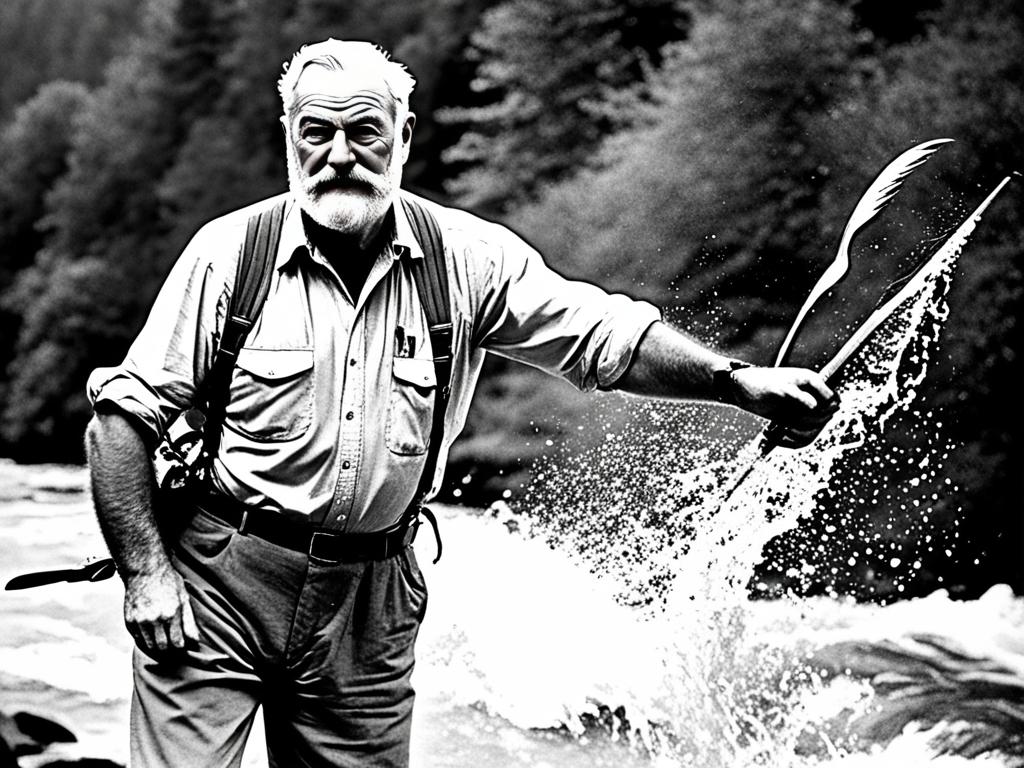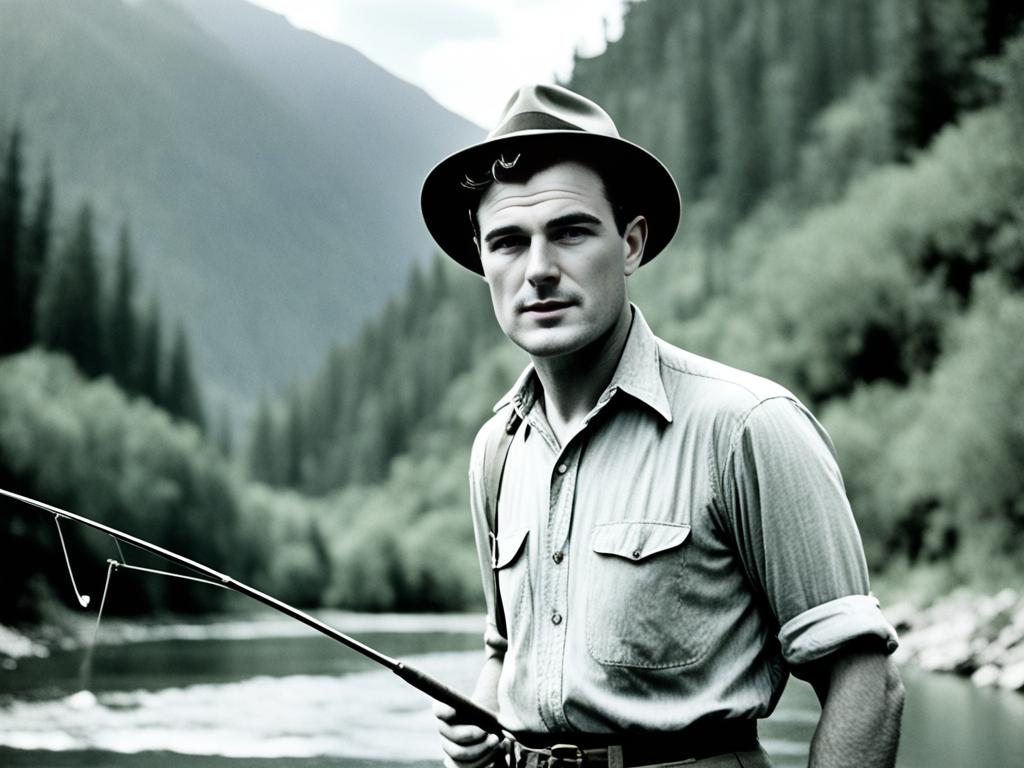
Ernest Hemingway: Biography of the American Literary Icon
Ernest Hemingway was a famous American writer. He made a big impact on 20th-century literature. His writing style was simple yet powerful, and his life was full of adventure.
Hemingway is seen as one of the most important writers of his time. His famous books like “The Old Man and the Sea,” “The Sun Also Rises,” and “A Farewell to Arms” have made him a legend. He even won the Nobel Prize in Literature.

Hemingway’s stories often came from his own life and the big events of his time. For instance, he fought in World War I and was part of the “Lost Generation,” a group of writers and artists. Moreover, his writing style, known for being very direct and full of hidden meanings, has influenced many writers. As a result, it still draws in readers all over the world.
Ernest Hemingway: The Legendary Author
Ernest Hemingway was born in 1899 in Oak Park, Illinois. Moreover, his early life was full of adventure and inspiration. Consequently, these experiences shaped his famous writing style.
He loved the outdoors, enjoying hunting, fishing, and exploring nature. Consequently, this passion for the natural world played a big role in his life.
Ernest Hemingway Early Life and Influences
Hemingway grew up in a family that valued adventure. Subsequently, he started writing as a young reporter for the Kansas City Star. There, he learned to write in a clear, simple way.
This skill helped shape his unique writing style. Moreover, it also influenced many other writers over the years.
War Experiences and the Lost Generation
In World War I, Hemingway was an ambulance driver on the Italian front. This experience deeply affected his views on war and people. It made him part of the lost generation of writers.
This group felt lost and unsure after the war. Hemingway’s life, his war experiences, and his link to the lost generation helped him write some of America’s most lasting literature.

Literary Masterpieces of Ernest Hemingway
Ernest Hemingway’s works are known for their clear, simple, and deep emotional stories. His famous novels like “The Sun Also Rises,” “A Farewell to Arms,” and “The Old Man and the Sea” show the human experience in a simple way.
These works, along with his short stories, made Hemingway one of the top writers of the 20th century. Additionally, his unique storytelling style, known as the “Iceberg Theory,” lets readers find deeper themes and feelings in the stories.
“The Sun Also Rises” looks at the disappointment and lost dreams of people after World War I. “A Farewell to Arms” tells a story of love and loss during World War I in Italy. “The Old Man and the Sea” is a story of never giving up, staying dignified, and the strength of the human spirit against hard times.

Hemingway’s writing has won the hearts of readers all over the world. Indeed, he is seen as one of the most important authors of his time. Furthermore, his works are still studied, talked about, and admired for their lasting effect on literature.
The Iceberg Theory: Hemingway’s Iconic Style
Ernest Hemingway’s writing style is famous for being simple and subtle. Specifically, he believed that the strongest feelings and ideas should be hinted at, not shown directly. Consequently, his stories were powerful and left readers thinking long after they finished reading.
Ernest Hemingway Concise and Understated Prose
Hemingway was a master of concise prose. Specifically, he picked each word carefully to express complex feelings with restraint. In contrast, his writing was different from the elaborate styles of his time. Consequently, it made his work memorable and influential.
Symbolism and Subtext
The ernest hemingway iceberg theory also used symbolism and hidden meanings. Hemingway didn’t spell out his themes. Instead, he used subtle hints that made readers think and find deeper meanings. This made his stories engaging and thought-provoking.

Hemingway’s writing, with its concise prose and symbolism, has changed literature. He showed how to express complex ideas with simplicity and subtlety. The “Iceberg Theory” is a key part of his legacy, proving that less can mean more in storytelling.
Ernest Hemingway: The Nobel Prize in Literature
In 1954, Ernest Hemingway won the Nobel Prize in Literature. He got it “for his powerful, style-forming mastery of the modern short story.” This award made him one of the most important writers of the 20th century.
The Nobel committee praised Hemingway for his unique way of telling stories. His works like “The Old Man and the Sea” and “The Sun Also Rises” were known for their simple yet powerful writing. They also used symbols and hidden meanings to show deep truths about people.
Hemingway’s Nobel Prize showed his great skill as a writer. Furthermore, it made him a symbol of American literature. His style still affects many writers today, who look up to him for inspiration.
FAQ
Who was Ernest Hemingway?
Ernest Hemingway was an American writer. He made a big mark on 20th-century literature. He was famous for his simple writing style and his exciting life.
What were some of Hemingway’s most famous works?
His famous works include “The Old Man and the Sea,” “The Sun Also Rises,” and “A Farewell to Arms.” These stories and novels are loved for their clear writing and deep feelings.
What was Hemingway’s writing style known as?
Hemingway’s style was called the “Iceberg Theory.” It was all about being simple and subtle. He thought the strongest feelings and ideas should be hinted at, not said directly.
How did Hemingway’s early life and experiences influence his writing?
Hemingway loved the outdoors and adventure from a young age. These interests shaped his writing. His time in World War I, where he drove an ambulance in Italy, deeply influenced his views on war and people.
What recognition did Hemingway receive for his literary achievements?
In 1954, Hemingway won the Nobel Prize in Literature. This was for his mastery of the modern short story. It showed his huge impact on literature and made him a key figure of the 20th century.



Great biography,he has lots of achievements.